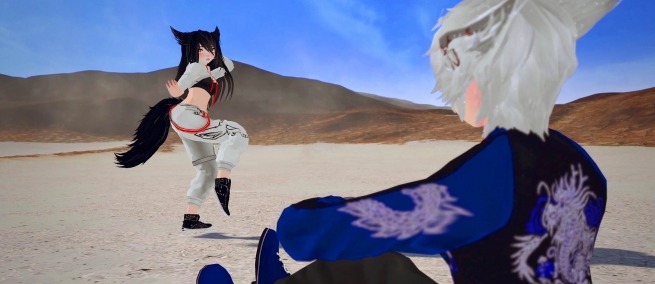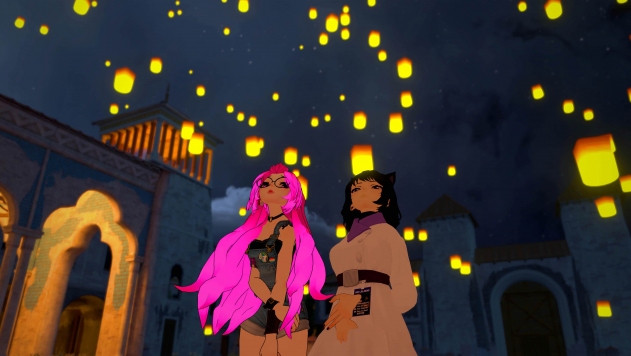
Joe Hunting’s debut feature documentary WE MET IN VIRTUAL REALITY was made while he was an avatar inside of the social platform VRChat. An observational portrait of different communities who connect on the platform, Hunting follows people learning sign language, couples in long distance relationships who use the platform to go on dates, as well as those suffering from the effects of social isolation during the COVID-19 pandemic for whom the platform is a necessary respite. We spoke with Hunting after the film’s world premiere at the Sundance Film Festival about the technical aspects of shooting in VR, his emphasis on the inclusivity and the positive nature of VRChat, and being potentially famous on the platform. WE MET IN VIRTUAL REALITY will screen next from March 4-6 as part of the True/False Film Fest.
Science & Film: Can you tell me about the production of WE MET IN VIRTUAL REALITY?
Joe Hunting: The entire film was shot in VR and I, myself, as a self-shooting director was in VR. I have a headset and full-body tracking, two trackers on my feet, one on my hip, and I am holding a camera in VR; in the physical world I’m just holding my controllers, but in VR my avatar is holding a full-fledged cinema camera where I can pull focus, zoom in and out, can fly it as a drone, shoot handheld—it can do everything that a real film camera can. When it comes to working with subjects and shooting interviews—doing documentary work—the process [in VR] is actually very similar and as organic as a real production. I am there, standing, present in the space with subjects and I can look over my camera monitor and see them in the space.
I came into VR in 2018, but my first films were shot outside of VR. The experience of filming in [VR] and interviewing in that way was something that I did for the first time in the beginning of 2020. Standing in a VR world and filming someone, capturing the magic of seeing someone speak and perform in their avatar, it was an amazing experience and felt like I was on the forefront of a new way of filmmaking—the start of cinema all over again. Once I’d wrapped on this other project that I was working on in 2020 I was immediately bursting to do something in longer form and embrace that experience of being with someone in VR and having it feel so tangible and real. Taking advantage of cinematic tools and iconography that you see in real films and bringing that into VR was a treat and an inspiring position to be in as an emerging filmmaker. It was an incredible experience, and I loved the production of the film.

A still from WE MET IN VIRTUAL REALITY. Courtesy of Sundance Institute | photo by Joe Hunting.
S&F: How long did it take you to make the film?
JH: I was in production for a steady year. I was in VR almost every other day writing shoot plans, going location scouting across the thousands of different user-created worlds. Then, on the weekends, I would shoot the events and interviews, because most things in VR happen on the weekends.
S&F: In the communities that you film, there is a feeling of inclusivity and acceptance. Do you think that is true of the VRChat community writ large, or was that something you were particularly interested in focusing on?
JH: VRChat is full of small bubbles of people. There is a community of VRChat at large, but it was interesting to me to go into the bubbles and share what the existing communities are like. For example, in WE MET IN VIRTUAL REALITY, we visit exotic dance clubs and then go to Helping Hands, which is a sign language community. Those two are completely different, and capturing that on film and comparing those two, but seeing how their contexts are similar in terms of the pandemic and people were finding community in those spaces, that was something I wanted to represent. I felt like representing smaller communities in depth would paint a broader portrait of what the platform was like.
S&F: It certainly seems utopian. How would you characterize it?
JH: Something I’ve been reading a lot as well is that WE MET IN VIRTUAL REALITY presents the utopian atmosphere of what VR can be like. My inspiration for focusing on the positive impacts of the technology was due to questions around the negativity of the platform which come very naturally. I think audiences can very easily question what the problems are, and there are problems: balance is the biggest one, prioritizing your virtual life over your physical life and really relying on either/or is certainly an issue. In the community at large there are problematic spaces which maybe would not be appropriate for some users. The freedom that VR can bring can put people in some dangerous spaces. But the film does not comment directly on those issues, and that’s because there is already so much stigma around VR and the internet in general that everyone is already aware of. So representing the positive impacts and understanding how we can use this technology for good and for education and for therapy and emotion and community, that was what I wanted to present.
S&F: On a formal level, the only work that I’ve seen that I would call comparable is machinima, which is different in that it’s manipulating code to present something closer to a narrative film. Nevertheless, did you take any inspiration from that form?
JH: I definitely considered machinima, but I don’t have any concrete routes in that style of filmmaking because it’s much more fictionalized and using flat-screen environments as well, so not in VR. There are two films that were seeds of inspiration: READY PLAYER ONE, which came out a couple years ago and is all about VR. It sensationalizes VR and makes it this huge world, and that inspired me to represent what we already have. Another film that uses VR in a documentary context is LIFE 2.0 by Jason Spingarn-Koff which came out a decade ago. That film investigates Second Life and interviews people there using a similar storytelling format as myself but relies on a lot more real-life imagery whereas I didn’t want to use any.
S&F: I am curious about your experience finishing this film then re-entering the VRChat community, what’s it like to be a famous director now?
JH: That’s a funny question, I’ve not been asked that! First of all, I actually ended up still going to Park City for Sundance even though the festival went virtual, which has some irony—we were the film crew probably the most prepared to be online, and the film crew that went to Park City, because we are all so desperate to meet in person for the first time! So, I’ve not been able to get in VR since the film premiered. I am based in the UK, I’ve got my VR in the UK, and I’m currently staying with one of my cast in Sacramento. So, I haven’t been in VR since the premiere, but during production of the documentary, word certainly got around that there was someone making a feature film. Because of me making documentaries in the past, everyone knew it was me. Whenever someone would see me, they would ask how the film was going. But I think a lot of the VRChat community, including myself to be honest, did not realize how far the film would go. It is such a dream come true to be premiering at Sundance, I think it’s unbelievable sometimes for the VR community to see a documentary from that community having the success it has. It’s such a special place to be—maybe I am famous! I’ll find out when I get back in. Celebrating the film with the community is important to me as well, so we will be doing VR screenings and VR premieres, as well as in Virtual Cinemas when it’s appropriate.
♦WE MET IN VIRTUAL REALITY is written, directed, filmed, and edited by Joe Hunting.
TOPICS